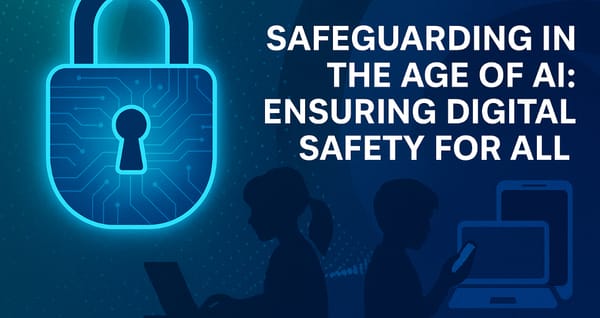Why Companies Must Prioritise Employee Safety In and Out of the Office

In today's rapidly evolving workplace environment, ensuring the safety of employees extends far beyond the physical confines of the office. From personal safety and harassment prevention to online security and addressing emerging threats like incel culture and geo-location stalking, companies have a significant role to play in protecting their workforce. This blog will explore why businesses must take a proactive approach to employee safety, both within and outside the workplace, and provide actionable steps to create a safer, more supportive environment.
The Importance of Prioritising Employee Safety
Physical, Emotional, and Online Environments
Ensuring a safe workplace involves much more than just preventing physical accidents. Emotional well-being and online security are equally crucial. Employers must recognise that the safety of their employees encompasses all aspects of their lives, especially as the lines between work and personal spaces blur with remote working and digital communication.
Organisational Responsibility
Personal safety and harassment prevention are not just individual responsibilities. Organisations must establish clear policies, provide training, and foster a culture of respect and support. By doing so, companies can create a safe environment where employees feel, and are, protected and valued.
Emerging Threats and Their Impact
Incel Culture and Online Harassment
Incel culture, a term derived from "involuntary celibate," refers to an online community predominantly comprised of men who express frustration over their lack of sexual and romantic relationships. This subculture often promotes toxic ideologies, including misogyny, entitlement to sex, and a belief that societal structures unfairly disadvantage them. The implications of incel culture extend beyond individual grievances; they can foster an environment where online harassment flourishes, creating an atmosphere of fear and intimidation, particularly for women.
As companies navigate the complexities of employee safety, understanding the underlying motivations and narratives within incel culture becomes essential. Employers must recognise that the influence of this subculture can manifest in workplace harassment or violent ideations, making it imperative to implement comprehensive training and awareness programs. By fostering an environment where respectful discourse is encouraged and inappropriate behavior is not tolerated, organisations can combat the insidious effects of incel culture, ultimately promoting a safer and more inclusive workplace for all employees.
Geo-Location Stalking
Geo-location stalking, where individuals use technology to track someone's location, has become a concerning trend. This invasion of privacy can lead to serious safety risks, particularly for women. Employers should educate employees about these dangers and implement measures to mitigate such risks.
Increase in Violence Against Women and Girls
There has been a worrying rise in violence against women and girls in public and private spaces. Workplaces can play a crucial role in creating safer communities by promoting awareness, providing support, and collaborating with local organisations and of the workplace. Implementing safety apps that provide emergency alerts, share location information with trusted contacts, or facilitate quick reporting of incidents can enhance employees' sense of security. Additionally, ensuring that all digital communication platforms adhere to high standards of security can protect employees from online threats. and law enforcement.
Abuse Statistics
Understanding the scope of abuse and harassment is essential for companies aiming to safeguard their employees. According to the National Intimate Partner and Sexual Violence Survey, nearly 1 in 5 women and 1 in 71 men in the United States have been raped at some point in their lives. Furthermore, the U.S. Equal Employment Opportunity Commission (EEOC) reported that over 25% of women and 15% of men have experienced sexual harassment in the workplace. Additionally, a recent study indicated that 60% of LGBTQ+ individuals have faced workplace harassment, with many citing the fear of retaliation as a barrier to reporting these incidents. These alarming statistics underscore the urgent need for businesses to implement robust safety measures and foster an inclusive environment that actively discourages abuse and harassment in all forms.
International Context
US and Australian Legislation
Across the globe, countries are introducing stricter regulations to combat harassment and ensure workplace safety. For instance, several US states, including California, Connecticut, and Delaware, mandate regular sexual harassment prevention training for all employees. Similarly, Australian states have introduced laws requiring businesses to take proactive measures in preventing workplace harassment.
UK Worker Protection Act
The UK is also stepping up its efforts with the Worker Protection Act, an amendment to the Equality Act 2010. Set to come into force in October 2024, this legislation mandates that companies take comprehensive steps to prevent sexual harassment, ensuring safe working environments. Employers must act now to comply and protect their employees.
With the implementation of the Worker Protection Act, companies will face heightened responsibilities regarding employee safety and harassment prevention. This legislation requires employers not only to establish comprehensive policies that explicitly prohibit sexual harassment but also to create mechanisms for reporting and addressing complaints effectively. Employers must ensure that their staff are well-informed about these policies and that everyone, from entry-level employees to upper management, is held accountable for maintaining a respectful workplace culture.
In addition to policy creation, companies will need to invest in regular training programs that equip employees with the knowledge to identify, prevent, and respond to harassment. This should include up-to-date information on the legal definitions of harassment, bystander intervention techniques, and resources for support when incidents occur. Furthermore, fostering an open dialogue where employees can express concerns without fear of retaliation is essential in nurturing a safe environment.
Finally, companies must regularly review and assess their workplace culture and practices to identify areas for improvement continually. This proactive approach ensures that organisations do not merely comply with the law but genuinely commit to safeguarding their employees’ well-being. By adopting these practices, companies will not only meet their legal obligations but also enhance employee morale, loyalty, and overall productivity.
Actionable Steps for Companies
Implement Comprehensive Training
Companies should provide thorough personal safety and harassment prevention training for all employees, focusing on both in-person and online environments. This training should be regularly updated to reflect the latest threats and best practices.
Establish Clear Policies
Clear and transparent policies on personal safety, harassment prevention, and bystander intervention are essential. Regularly reviewing and updating these policies ensures they remain effective and relevant.
Encourage Open Communication
Creating open communication channels within the organization allows employees to report safety concerns or harassment incidents without fear of retaliation. This fosters a culture of trust and support.
Conduct Regular Safety Audits
Regular safety audits of the physical workplace can identify potential security gaps. Measures such as enhanced lighting, secure entry systems, and safe working protocols for late or isolated work can significantly improve safety.
Provide Support Resources
Offering resources and support for employees who may be victims of stalking or harassment, including legal and counselling services, is crucial. This demonstrates that the company cares about its employees' well-being beyond just their productivity.
Importance of Bystander Training
Bystander training empowers employees to intervene safely and effectively when they witness harassment or unsafe behavior. This training can help create a workforce that actively contributes to a respectful and safe environment.
Bystander training is an educational approach designed to empower individuals to recognise and safely intervene in situations of harassment or unsafe behaviour. This type of training helps participants understand the dynamics of bullying, harassment, and violence, equipping them with the tools and confidence to act when they witness inappropriate actions. Participants learn various intervention strategies, ranging from direct approaches—such as addressing the behaviour in the moment—to indirect methods, like seeking assistance from authorities or supporting the affected individual afterward. Effective bystander training fosters a sense of community responsibility, promoting a culture where everyone plays a part in maintaining a safe and respectful environment. By encouraging individuals to take action when witnessing harmful incidents, companies can significantly enhance their collective commitment to employee safety.
Conclusion
Employee safety is a multifaceted issue that requires a proactive and comprehensive approach from organisations. By prioritising physical, emotional, and online safety, addressing emerging threats like incel culture and geo-location stalking, and complying with international regulations, companies can create a safer, more supportive environment for their workforce.
Let's make employee safety a priority. Book a call with one of our experts at Stay Safe Global to learn how we can help you implement these strategies and ensure your workplace is a safe and welcoming space for everyone.
By following these guidelines, companies cannot only protect their employees but also foster a culture of safety and respect that benefits everyone.





